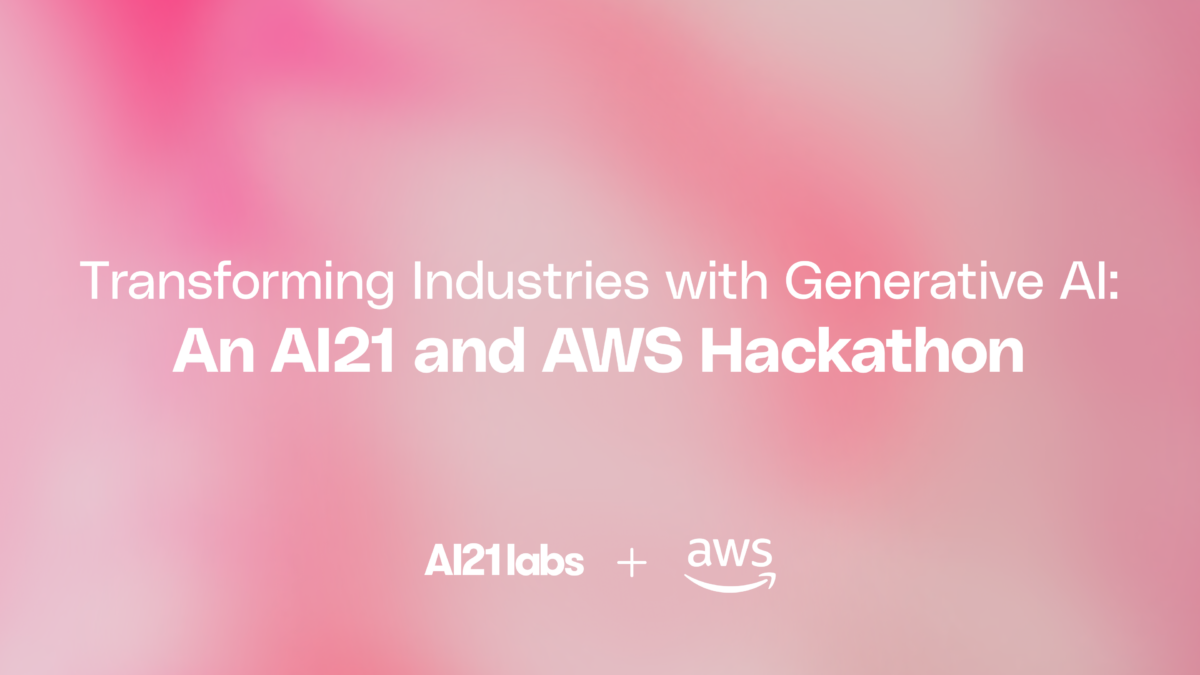Table of Contents

Transforming Industries with Generative AI: An AI21 and AWS Hackathon
The AI21 Hackathon with AWS was an exciting event that brought experts together to explore the latest trends and challenges in Generative AI (GenAI) through real-world use cases, including customer support, grounded content generation, and guardrails for Large Language Models (LLMs).
With over 50 AWS Solutions Architects and other hand-picked AWS GenAI practitioners in attendance, the hackathon provided an opportunity to gain hands-on experience in using AI to solve complex problems and to learn from experts in the industry.
With AWS executive sponsorship from Greg Pearson, VP of AWS Global Sales and Francessca Vasquez, VP of AWS ProServe and GenAI Innovation Center, the event was a thrilling demonstration of GenAI’s transformative potential across various industry sectors.
The GenAI Landscape
The AI21 team presented how GenAI is being used today in various industries, such as retail and financial services, and how these trends affect the architecture for deploying GenAI pipelines in the real world. They also shared best practices for using and selecting AI21 models, such as prompt engineering guidelines, and best practices for avoiding hallucinations and inaccuracies when using LLMs.
The AI21 team also covered use cases across the healthcare, retail, and finance industries where Task Specific Models (TSM)—trained to execute precise tasks—are a more efficient and reliable choice than a general-purpose LLM.
As AI21 CEO Ori Goshen shared at re:Invent 2023, Task Specific Models allow for “accurate, comprehensive, and grounded responses,” essential “for minimizing hallucinations.” Built with out-of-the-box precise functionality, these models eliminate the need for a lengthy prompt engineering process, reducing the time-to-value and allowing enterprises to scale deployment.
During the hackathon, AWS teams showed how they could use AI21 LLM and TSM models for various GenAI use cases, including:
- Guardrails for large language models: Develop prompts and underlying GenAI mechanisms that are resilient against harmful content injection.
- Grounded content generation using GenAI models: Generate commercial content (e.g. product descriptions) using product and other raw data.
- Improve customer support with Generative AI: Enhance customer support by using AI21 GenAI models to analyze previously resolved tickets and provide accurate current case resolutions.
- Structured summarization of multiple documents: Generate summaries of topics where the source data is 1) scattered across many different documents and 2) comes from a large corpus of data.
- GenAI for advertising creation: Develop a GenAI platform for creating dynamic advertising content, which automates and enhances various aspects of advertising, such as: idea generation, content creation, localization, targeted advertising, and social media integration.
- Structured summarization from call transcripts: Extract or summarize data from conversation histories that remains consistent with the original transcript.
Key Themes and Learnings
A key takeaway from the hackathon was the importance for LLMs to remain grounded in enterprise data. In all of the use cases, teams did their best to assure GenAI outputs that were both high quality and grounded in the input data, using Retrieval Augmented Generation (RAG).

For example, the “Guardrails for large language models” project—in which a “blue” team built a secure system, while a “red” team attempted to undermine it— leveraged prompt engineering techniques to help ensure that the red team’s prompt injection attacks were ignored, as well as ensuring that responses remain on topic.
A second key takeaway was the judicious use of Task Specific Models. AI21’s TSMs support complex workflows, and—crucially—are guaranteed to remain on-task. For example, the Contextual Answers TSM can be used in tandem with the Jurassic-2 LLM to power a customer chatbot, searching a company’s organizational knowledge base to offer grounded responses in natural language.
A third takeaway was integrating AI21 models into AWS native services, with TSMs now integrated with a number of AWS services, such as Amazon Bedrock, Amazon SageMaker, Amazon OpenSearch, Amazon Lex, AWS Lambda, and others.
AWS x AI21 Hackathon Summary
Amidst the backdrop of a highly dynamic field, the AWS Hackathon and AI21 event offered attendees valuable insights into the latest GenAI trends and challenges. In addition to talks from industry experts, attendees also gained valuable hands-on experience directing GenAI to solve complex problems, with a particular (and timely) focus on creating LLM guardrails, improving customer support, and generating grounded content.
The event also looked forward to the next stages of GenAI, highlighting the practice of adopting TSMs—instead of more multi-purpose LLMs—to perform sophisticated workflows with guaranteed on-task performance.
Between the talks and the exciting outcomes of the hackathon, the event highlighted the power of GenAI and its potential to revolutionize various industries, especially when taking advantage of AI21 and AWS’ joint capabilities.



